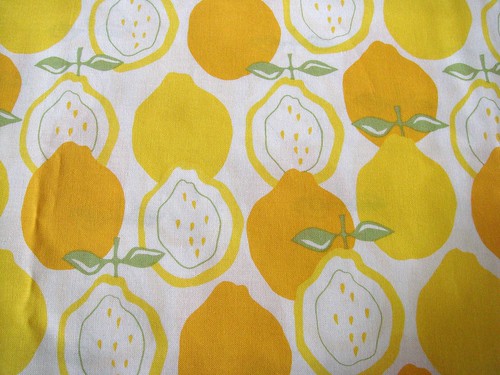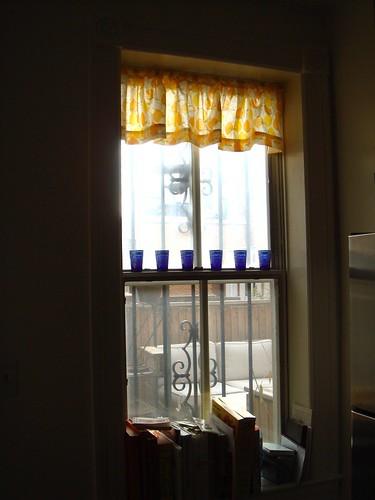Curtains
My kitchen has 9' tall ceilings and 6' tall windows. Wonderful for a kitchen as I love the natural light, but I just had to dress them up somehow. So I have sewn some valances to perk up the kitchen with lots of happy, summery color.
I had been on the hunt for a white cotton fabric with lemons and lemon slices for months. I must have invented it in my head, because I could never find one in a fabric store or online. All I wanted was a bold, graphic print in yellow and orange. Images of cherries? All over the place. Allover realistic lemons? Sure. There were pears and apples and all kinds of other stuff, but no lemons. And most of them seemed to have a countrified gingham background or too much pink or blue. Bleh. I wanted something funkier.
Luckily, my mom was able to find a great graphic lemon print. While it wasn't exactly as I'd envisioned it, it met the requirements of orange and yellow on white, and stylized lemons.

Yum.
So after making some measurements and hunting down tension rods I threw together some curtains. Somehow tension rods have become really hard to find. There is a Restoration Hardware on my block, and when I went in and asked for them, the guy looked at me like I had grown a third arm. I have to keep reminding myself that Restoration Hardware should really be called the Almost-Martha Decorating Outpost or Overpriced Embellishments or More Crap You Don't Need to Decorate Your House With. They don't actually have hardware besides drawer pulls, and I find that really irritating. Okay, anyway. Curtains.
I didn't take a million photos of the curtain-making process, because I am a very, very lazy seamstress and I'd embarrass myself by my imprecise methodology in the face of all the perfectionism out there. But I can briefly describe the process.
Lazy, Lazy Curtains:
1. Buy a whole bunch of fabric, more than you think you'll need. Don't bother to wash it or iron it yet unless it's actually dirty or totally crumpled. You can use leftovers for fabric napkins, a bread-basket liner, small tablecloth, or throw back into your stash.
2. Measure the width of your window. In my case, this was about 30".
3. Get a tension rod that will fit in that width. I got mine from Linens 'n' Things after a helpful Freecycle tip.
4. Figure out how long you want your valance to be. In my case, I estimated 12-14".
5. To determine the size to cut your fabric for each curtain, multiply the width of your window by 2 or even 3, and add 6" or more to the length. If your fabric isn't wide enough, you'll have to seam it. I cut my fabric to a length of about 20". As the width was only 45", I had to cut three strips for two curtains and cut the last strip in half to piece onto the two longer sections. As the print didn't match up exactly, I had pieces left over. But now I had 2 pieces about 60" by 18". All the extra fabric is key to make it ruffle in the window and to give you nice heavy hems.
6. If you're lazy like me, leave the selvedges on so you don't have to make as many hems. I only had to sew down one edge; all the rest are just selvedges.
7. Fold over the top once at 1/4" and again at maybe 1 1/2" to make the rod pocket. Check to make sure your rod fits in it. Sew this down. An iron is your friend to make the folds, if you're lazy like me and don't like to pin anything.
8. Measure how long you want the curtain to be again and fold up the bottom and turn it under to make the hem. Sew this one down, too. Iron out any major nasty wrinkles as you do this.
9. Thread on the rod and stick it into the window. You'll never look that closely at them again, and Martha Stewart will probably never visit your house, so it doesn't matter if your seams are a little crooked or your pattern doesn't match exactly.
10. Dance in your kitchen because it looks awesome and only took you an hour.
11. Take a really crappy photo with light coming in from behind to show everybody how your curtains are nice and yellow in your nice white kitchen and how it really perks up the place, honest.

I had been on the hunt for a white cotton fabric with lemons and lemon slices for months. I must have invented it in my head, because I could never find one in a fabric store or online. All I wanted was a bold, graphic print in yellow and orange. Images of cherries? All over the place. Allover realistic lemons? Sure. There were pears and apples and all kinds of other stuff, but no lemons. And most of them seemed to have a countrified gingham background or too much pink or blue. Bleh. I wanted something funkier.
Luckily, my mom was able to find a great graphic lemon print. While it wasn't exactly as I'd envisioned it, it met the requirements of orange and yellow on white, and stylized lemons.

Yum.
So after making some measurements and hunting down tension rods I threw together some curtains. Somehow tension rods have become really hard to find. There is a Restoration Hardware on my block, and when I went in and asked for them, the guy looked at me like I had grown a third arm. I have to keep reminding myself that Restoration Hardware should really be called the Almost-Martha Decorating Outpost or Overpriced Embellishments or More Crap You Don't Need to Decorate Your House With. They don't actually have hardware besides drawer pulls, and I find that really irritating. Okay, anyway. Curtains.
I didn't take a million photos of the curtain-making process, because I am a very, very lazy seamstress and I'd embarrass myself by my imprecise methodology in the face of all the perfectionism out there. But I can briefly describe the process.
Lazy, Lazy Curtains:
1. Buy a whole bunch of fabric, more than you think you'll need. Don't bother to wash it or iron it yet unless it's actually dirty or totally crumpled. You can use leftovers for fabric napkins, a bread-basket liner, small tablecloth, or throw back into your stash.
2. Measure the width of your window. In my case, this was about 30".
3. Get a tension rod that will fit in that width. I got mine from Linens 'n' Things after a helpful Freecycle tip.
4. Figure out how long you want your valance to be. In my case, I estimated 12-14".
5. To determine the size to cut your fabric for each curtain, multiply the width of your window by 2 or even 3, and add 6" or more to the length. If your fabric isn't wide enough, you'll have to seam it. I cut my fabric to a length of about 20". As the width was only 45", I had to cut three strips for two curtains and cut the last strip in half to piece onto the two longer sections. As the print didn't match up exactly, I had pieces left over. But now I had 2 pieces about 60" by 18". All the extra fabric is key to make it ruffle in the window and to give you nice heavy hems.
6. If you're lazy like me, leave the selvedges on so you don't have to make as many hems. I only had to sew down one edge; all the rest are just selvedges.
7. Fold over the top once at 1/4" and again at maybe 1 1/2" to make the rod pocket. Check to make sure your rod fits in it. Sew this down. An iron is your friend to make the folds, if you're lazy like me and don't like to pin anything.
8. Measure how long you want the curtain to be again and fold up the bottom and turn it under to make the hem. Sew this one down, too. Iron out any major nasty wrinkles as you do this.
9. Thread on the rod and stick it into the window. You'll never look that closely at them again, and Martha Stewart will probably never visit your house, so it doesn't matter if your seams are a little crooked or your pattern doesn't match exactly.
10. Dance in your kitchen because it looks awesome and only took you an hour.
11. Take a really crappy photo with light coming in from behind to show everybody how your curtains are nice and yellow in your nice white kitchen and how it really perks up the place, honest.

Comments